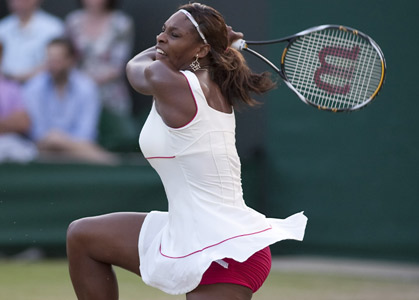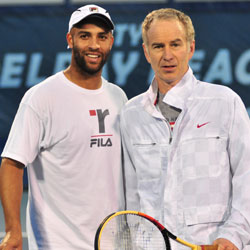35DFA427-F6E8-40DE-991F-1EAF65985E1C
By Franklin L. Johnson
© Fred Mullane and Susan Mullane/Camerawork USA
(July 5, 2010) "All the world's a stage," Shakespeare wrote long before the first ball ever bounced for a clean winner across the pristine lawn of the All England Club.
The Bard from Stratford obviously isn't around to see just how brilliantly the muscular Mallorcan, Rafael Nadal, and the Compton crusher, Serena Williams, performed on the game's grandest stage, Centre Court Wimbledon.

A beauty of our great game is the vital role the stage plays as a character actor in the two-player drama that is a Grand Slam final.
Would Guga Kuerten's French Open victory had been as memorable as it was had the charismatic Kuerten not traced a huge heart in the red clay to symbolize his heart-felt appreciation for the Parisian major and its fans?
The image of Rafael Nadal falling to a complete collapse on the worn-out grass with the green wall devoid of sponsorship graffiti setting tbe backdrop while camera flashes popped like fireflies in the waning light gives Nadal's classic five-set win over reigning champ Roger Federer in the 2008 Wimbledon final the atmospheric feel of a sporting legend committed to cinematic celluloid.
A Grand Slam center court is more than a moveable stage, it is a major player in the drama that unfolds.
So the final scenes of the men's and women's Wimbledon finals were bittersweet moments: we saw the two best players on the planet grace the game's great stage with convincing closure.
But what happens when the stage shifts?
If Wimbledon is a tennis cathedral, then the monstrosity that is Arthur Ashe Stadium boasts all of the dramatic atmosphere of a drive-in movie theater built beside the runway of La Guardia Airport.
Don't get me wrong: as a native and life-long New Yorker, I know better than most the US Open is one of the greatest sporting experiences in the world. In three decades of attending the Open, I've seen some of the most dazzling tennis of the Open Era. But the lesson the USTA needs to learn from Wimbledon is when it comes to tennis, bigger is not always better.
The tennis circus comes to New York starting on August 30th, but before it takes a bite out of the Big Apple let's take a look at the state of the American game and our greatest stage, the US Open.
As a life-long supporter of American tennis I am proud to see how the Williams sisters, Bryan brothers and Andy Roddick have represented our nation as top 10 mainstays who have competed with toughness, tenacity and a tremendous commitment to bringing their best when they step out on the court.
What have we, the nation's tennis players, coaches and fans, learned from these players as they each had toward the final act of their glorious careers? What will their legacy mean to the future of American tennis.
The Bryan brothers turned 32 in April, Venus celebrated her 30th birthday last month, Roddick will be 28 the day the US Open begins and the revitalized Serena will turn 29 before September ends.

America's champions are maturing, but are our next generation of future champs growing?
Where would American tennis be without these five players?
We'd probably be wishing we were Belgium or Bulgaria.
Glance at recent Grand Slam draws and look at the impact smaller nations like Belgium, Bulgaria, Serbia, Sweden and the Czech Republic have had (not to mention Switzerland, home to 16-time Grand Slam champion Roger Federer, and Mallorca, the sea-side community that spawned the Raging Bull, Rafa Nadal).
Let's cut to the meat of the matter: true champions are getting rarer than black pearls these days. Nobody wants to pay the cost to be the boss anymore. It's a sign of our futile nation. We all want to be No. 1 without earning the right to be on top. If this isn't a sign of a nation in serious decline, I don't know what is.
The champs these days in tennis are coming out of nations with populations smaller than the number of folks who passed through the lobby in my former Chelsea apartment building.
Mallorca? You'd think they'd never heard of a sport like tennis in such a tiny place.
There's not enough population in some of these nations to choose up a decent softball game let alone produce champions. There's something to be admired about champions coming from areas where the opportunities aren't that great — it reveals a real, raw desire from the players and their families who make it.
Remember one thing: inspiration and apathy can come from the top down.
I find it odd that so many nations are taking their decline in stride, like it's some kind of a good thing. Listen closely and hear the bureaucrats recycle the tired old "tennis is cyclical...." "champions come in cycles...." spin. When they start spinning the cyclical cycle alibi on you then you know they're taking decline in stride.
I don't know about you, but I don't like the idea of being buried before my time is up. Except for the Williams sisters and A-Rod, who have we got?
All I hear out in the distance is the chirping of crickets.
Sure, Big John Isner showed enough guts and grit and stood so tall he made Big Ben look like a pocket watch in his historic 11-hour, 5-minute win over Nicolas Mahut. But will history remember Big John, drained from that 70-68 drama, lost in the second round? Sam Querrey is a big-hitter with California cool who has won three titles on three different surfaces, but when will Q Ball reach his first major quarterfinal or win a Masters 1000 title? Vania King is a phenomenal story, winning the Wimbledon women's doubles title with Yaroslava Shvedova, who hails from that tennis hotbed that is Borat's homeland, and Vania plays the type of energetic, all-court tennis a highly-hyped young American, Melanie Oudin, could learn from. The U.S. Fed Cup team, led by captain Mary Joe Fernandez, returns to the Fed Cup final for the second straight year and will host defending champ Italy in San Diego. Lindsay Davenport has come back to play doubles.
But aside from these sudden spikes — and the hope that Serena stays healthy enough to produce another five years of dynamic, dominant tennis — what do we have to look forward to in American tennis?
This could be a golden era in American tennis with the greatest sister act in tennis history led by arguably the greatest player in women's tennis history cleaning up the major silverware, the Bryan brothers chest-bumping their way into history as they stand on the verge of collecting the Open Era record for most doubles titles and Roddick delivering the US Open, Davis Cup, World No. 1 ranking and setting an example of sportsmanship by supporting Shahar Peer and blowing off defense of his Dubai title and by the class he showed in a gut-wrenching loss to Federer in the 2009 Wimbledon final.
But when this group runs its final lap, who will be waiting to take the baton?
The USTA has made a lot of noise about how much money it's pouring into discovering and training young talent. The other nations seem to be years ahead of us in this sort of national approach to producing suitable competitors, just scan the ITF Junior Rankings and on first glance you might think (USA) appears about as often as (MARS) in the rankings, but there are actually four Americans (two boys, two girls) in the top 25 of the boys' and girls' world rankings.
Don't talk to me about dollars, show me some sense.
When Venus, Serena, Andy, Bob and Mike hang up their racquets will we turn into an England with winning to become a long ago memory?
We don't seem to appreciate history and the achievements of past champions in this country.
Here's a challenge to you, readers, if you go to the US Open this year ask 10 kids this question: "Who is Althea Gibson?"
I'm sure the majority wouldn't have a clue and this has nothing to do with her color. It has everything to do with the lack of appreciation for those who made great strides in our national history. You don't sense this loss of historic context when you watch sports in other nations.
I am not stating small nations are taking over tennis: look at the rise of the Chinese women or the fact Russia had the women's singles and doubles finalists at Wimbledon.
I am simply saying smaller nations have a representation among the elite players which wasn't the case a few decades ago. This is a fact.
Here's another fact: the most successful recent American champions are products of parental or family support or independent coaching.
Go down the list: Arthur Ashe, Chris Evert, Jimmy Connors, John McEnroe, Andre Agassi, Jim Courier, Pete Sampras, Michael Chang, Jennifer Capriati, Todd Martin, Malivai Washington, Lindsay Davenport, Bob Bryan, Mike Bryan, Serena Williams, Venus Williams and Andy Roddick.

Outline how most of our recent champions made it and it was, in most cases, family support and private coaching.
You outline how most of our recent stars in America got where they did mostly with private coaching.
So, where is all that money the USTA makes going?
I was against the building of the Arthur Ashe stadium monstrosity. I handed out fliers on opening day stating if Arthur was alive at that time he'd be out front picketing that stadium with his name on it.
I wasn't against a new stadium, but simply supporting one which was favorable to the fans. The court-side condominiums are a disgrace to the egalitarian nature of our sport. The last thing we needed was an overt example of conspicuous consumption right down where the whole world could see it on TV.
This is what's killing our sport today — we've been sold out by officials who have put the pursuit of the dollar sign ahead of attracting American kids to our great game. The connected are still in control of the decision-making process which hasn't shown any real progress despite the flow of funds and interest. It's been close family support rather than the USTA which helped many if not most of our recent champions.
How come no one at the USTA and other governing bodies has come right out and said this is so? We all know this is the case. So, why don't they admit to the obvious?
Less than two months before the first ball is struck in New York City, appreciate our current champions for their contributions, but be concerned about the immediate future of American tennis.
As long as no one wants to mention the presence of this 800-pound gorilla sitting in the middle of the American tennis living room, we won't be able to make the significant changes necessary to bring our sport into the present century.
You gotta first admit there is a problem before useful acts to solve it are set into motion.
Tennis Now contributing writer Franklin L. Johnson is a writer, poet and avid tennis player based in New York. He has covered professional tennis for three decades. His recent columns include Tomas Berdych Played Tame Final and A Case For Vera.